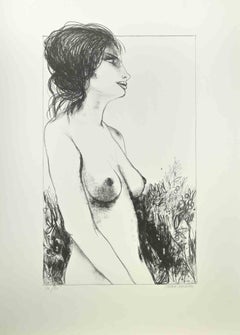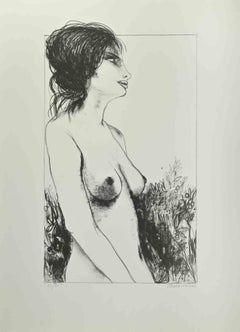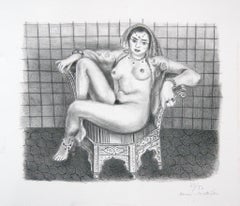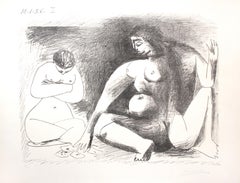Want more images or videos?
Request additional images or videos from the seller
1 of 7
Annette Standing - Original Lithograph after Alberto Giacometti - 19611961
1961
Price:$780.69
$960.85List Price
About the Item
- Creation Year:1961
- Dimensions:Height: 15.75 in (40 cm)Width: 11.82 in (30 cm)Depth: 0.08 in (2 mm)
- Medium:
- After:Alberto Giacometti (1901 - 1966, Swiss)
- Period:
- Condition:Insurance may be requested by customers as additional service, contact us for more information.
- Gallery Location:Roma, IT
- Reference Number:Seller: M-1150471stDibs: LU65037504702
About the Seller
4.9
Platinum Seller
Premium sellers with a 4.7+ rating and 24-hour response times
1stDibs seller since 2017
7,874 sales on 1stDibs
Typical response time: 1 hour
Authenticity Guarantee
In the unlikely event there’s an issue with an item’s authenticity, contact us within 1 year for a full refund. DetailsMoney-Back Guarantee
If your item is not as described, is damaged in transit, or does not arrive, contact us within 7 days for a full refund. Details24-Hour Cancellation
You have a 24-hour grace period in which to reconsider your purchase, with no questions asked.Vetted Professional Sellers
Our world-class sellers must adhere to strict standards for service and quality, maintaining the integrity of our listings.Price-Match Guarantee
If you find that a seller listed the same item for a lower price elsewhere, we’ll match it.Trusted Global Delivery
Our best-in-class carrier network provides specialized shipping options worldwide, including custom delivery.You May Also Like
Antonia - Limited Edition, Figurative, Contemporary, semi-nude, female, feminine
By Charlie Mackesy
Located in Knowle Lane, Cranleigh
Antonia is a limited edition lithograph, based on a black pastel drawing, by Charlie Mackesy. The edition is limited to 150 and have been signed by Mac...
Category
Early 2000s Feminist Figurative Prints
Materials
Lithograph
$6,809
H 29.14 in W 20.87 in D 1.78 in
Girl on Gold - Limited Edition, Figurative, Contemporary, semi-nude, feminine
By Charlie Mackesy
Located in Knowle Lane, Cranleigh
Girl on Gold is a limited edition lithograph, based on an oil painting by Charlie Mackesy. The edition is limited to 120 and have been signed by Mackesy in Pencil. The elegance and femininity depicted in this image captures a feminine nature and emits beauty in the human form and a warmth with its golden hues.
"I am cautious to explain what I think the work is saying for fear of taking away from you something you have seen and I have not. I could conclude by saying that life is precious and faith is a journey and sometimes art can give a small glimpse of these moments seen, and unseen. I think GK...
Category
2010s Other Art Style Figurative Prints
Materials
Lithograph
$2,476 Sale Price
20% Off
H 22.25 in W 16.54 in D 1.19 in
Internationale Kunst Ausstellung, Dresden
Located in London, GB
Osmar Schindler, (German 1867-1927), Internationale Kunst Ausstellung, Dresden, 1897 Lithograph, signed (in the plate) (middle right), 96cm x 75cm (100...
Category
1890s Art Nouveau Figurative Prints
Materials
Paper, Lithograph
Deutsche Werkbund-Ausstellung (German Workers Union Exhibition Art)
By Peter Behrens
Located in London, GB
Peter Behrens, (German 1868-1940), Deutsche Werkbund-Ausstellung, 1914, Deutsche Werkbund-Ausstellung, Kunst in Handwerk, Industrie und Handel Archit...
Category
1910s Art Deco Figurative Prints
Materials
Paper, Lithograph
$8,598
H 37.41 in W 25.6 in D 0.79 in
Italian 1980s Ugo Attardi Signed Work on Paper Nude of Woman
By Ugo Attardi
Located in Roma, IT
Italian 1980s Ugo Attardi Signed Work on Paper Nude of Woman
A beautiful "Prova d'Artista" Pop Art-inspired graphic work by one of Italy's greatest modern artists, Ugo Attardi.
It d...
Category
Late 20th Century Modern Nude Prints
Materials
Lithograph
$1,921
H 32.88 in W 39.77 in D 2.76 in
Scotland Yard (Oo La La) Jim Dine pale pink erotic hairstyles Ron Padgett poetry
By Jim Dine
Located in New York, NY
This cheeky, pastel pink print depicts a range of intimate styles, a tongue-in-cheek recollection of the gridded haircuts displayed outside barber shops. It is from the Oo La La portfolio of 15 lithographs printed offset from zinc plates, drawn by both artists. Produced in collaboration with Ron Padgett...
Category
1970s Pop Art Nude Prints
Materials
Lithograph
Untitled framed lithograph by Aristide Maillol
By Aristide Maillol
Located in Boca Raton, FL
Framed lithograph of female nude of pastel by Aristide Maillol. Initials in lower-right corner. Framed under glass in wooden frame.
Category
20th Century Modern Figurative Prints
Materials
Lithograph
Nude Lying Down framed lithograph of woman by artist Aristide Maillol
By Aristide Maillol
Located in Boca Raton, FL
Framed lithograph of a female Nude Lying Down pastel by artist Aristide Maillol. Image size: 9 1/4 x 14 1/2 inches. Framed under glass in wooden frame.
Category
20th Century Modern Figurative Prints
Materials
Lithograph
$450
H 18.5 in W 23.75 in
Untitled nude woman framed lithograph by artist Aristide Maillol
By Aristide Maillol
Located in Boca Raton, FL
Framed lithograph of a female nude pastel by artist Aristide Maillol. Image size: 12 1/2 x 9 1/2 inches. Framed under glass in wooden frame.
Category
20th Century Modern Figurative Prints
Materials
Lithograph
Three women. 9/50., Paper, etching, 23x58 cm
By André François
Located in Riga, LV
Three women. 9/50., Paper, etching, 23x58 cm
Category
1980s Surrealist Figurative Prints
Materials
Paper, Lithograph
$432 Sale Price
20% Off
H 9.06 in W 22.84 in D 0.04 in
More From This Seller
View AllNude of Woman - Lithograph by Carlo Marcantonio - 1970
By Carlo Marcantonio
Located in Roma, IT
Nude of Woman is a Lithograph realized by Carlo Marcantonio in 1970s.
This original print is hand signed. This is an edition of 50 prints plus some artist's proofs.
Prints are the ...
Category
1970s Contemporary Figurative Prints
Materials
Lithograph
Nude of Woman - Lithograph by Carlo Marcantonio - 1970
By Carlo Marcantonio
Located in Roma, IT
Nude of Woman is a Lithograph realized by Carlo Marcantonio in 1970s.
This original print is hand signed. This is an edition of 50 prints plus some artist's proofs.
Prints are the ...
Category
1970s Contemporary Figurative Prints
Materials
Lithograph
Jeune Hindoue - Lithograph by Henri matisse - 1929
By Henri Matisse
Located in Roma, IT
"Jeune Hindoue" is an original hand-signed and numbered lithograph realized by Henri Matisse in 1929. It belongs to an edition of 50 prints. Excellent condition.
Reference : Duthuit...
Category
1920s Fauvist Figurative Prints
Materials
Lithograph
Deux Femmes Accroupies - Lithograph by Pablo Picasso - 1956
By Pablo Picasso
Located in Roma, IT
Realized by Picasso in 1956. Lithograph on Arches Paper.
Hand Signed and numbered.
Edition of 19/50.
Ref. Bloch n.790.
Category
1950s Cubist Figurative Prints
Materials
Paper, Lithograph
La Fille au Chapeau - Lithograph by Pablo Picasso - 1959
By Pablo Picasso
Located in Roma, IT
Lithograph on Arches wove paper, with watermark, realized by Picasso in 1959.
Image dimension: 64x59 cm; Sheet dimension 65.5x50.5 cm.
Hand signed in pencil lower right. Edition of...
Category
1950s Cubist Figurative Prints
Materials
Lithograph
Two Erotic Scenes - Lithograph - Early 20th Century
Located in Roma, IT
Pair of erotic lithographs realized in France in the early 20th century.
In very good condition, each has a contemporary frame cm. 43x33.
Category
Early 20th Century Modern Figurative Prints
Materials
Lithograph



